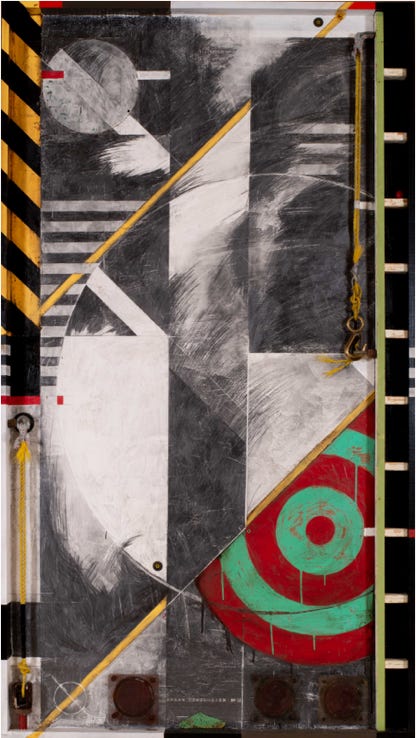Mary Snyder Behrens, Drawn Conclusion No 12 Shroud and Shadow (2004). Mixed media. 48h x 73w.
Mary Snyder Behrens, Drawn Conclusion No 12 Shroud and Shadow (2004). Mixed media. 48h x 73w.
TRAMMEL SERIES
There is also a subset of “miniature” works that, in style if not in scale, are closely related to the larger American Canvas series. These too are assemblages, enclosed in box-like limits, but in their largest dimension they measure no larger than 6 inches. She produced an unusual number of these, as many as seventy, and even though their diminutive size gives them less physical presence than her intrusive larger works, there are some that are simply unequaled. These are not titled but numbered, and American Canvas 006 and 015 (2002) are some of her finest achievements.
Beginning in 1997, Behrens was the recipient of an artist’s grant from the Iowa Arts Council. She received comparable grants for the next two years, followed by a fourth in 2002. Her rate of production continued. Especially momentous was the completion of another large-scale series, comprised of her largest, most sculptural works. Called Drawn Conclusions, these too were housed in box-like panels, and were made by intermixing paint with found components.
A pivotal innovation in Drawn Conclusions was the use of layers of plaster, sometimes
Mary Snyder Behrens, Trammel Box: White Wish III (2005). Mixed media. 3.75h x 2.5w x 1d. Private collection.
CLICK ON IMAGES TO ENLARGE
stained or painted, which she scored or etched into with graphite. Another distinction was the inclusion of found components that were larger than those in her earlier work. For example, conspicuous use was made of heavy fibrous twisted rope. Another was white bed sheets, draped in

Mary Snyder Behrens, Drawn Conclusion No 11 (2004). Mixed media. 73h x 41w x 3.5d. Collection of UNI Gallery of Art.
Mary Snyder Behrens, Trammel Box: Home II (2005). Mixed media. 3.75h x 2.5w. Private collection.
ways that bring to mind realistic portrayals of drapery in Neo-Classical paintings. Of these works, among the most enduring is No. 13: Faith Is a Potent Opiate (2004), which, when these were first shown publicly at the University of Northern Iowa (2005), it was used on the catalog cover.
Mary Snyder Behrens, American Canvas No 006 (2002). Mixed media. 5.5h x 4w. Private collection.
It may be helpful at his point to look at a concurrent but different series. In 2004-2005, she created a body of miniature works called Trammels. She made scores of these, and some of them are among her finest pieces. At first glance, they may appear to be similar to her small-scale American Canvas works from 2002. But the Trammels are even smaller. They are made of fiber materials, and from a distance, appear to be wrapped bundles or packages. They are all the same size, each measuring 3.75 inches high by 2.5 inches wide, for the simple reason (which the viewer is never informed of) that the object contained in each package is the same in all of them. Since the artwork is never taken apart, the viewer is left to imagine what is contained inside the package—or not.
While no two Trammels are the same, it is tempting to see them as clusters on the basis of colors, styles and materials used. Partly because of their size (small enough to fit the hand), these works cannot help but feel special, fragile, even vulnerable. At the same time, when examined closely, they have an impact equal to things that exceed human scale. The intricacy of the Trammels is astonishing, as is the rich range of methods used in creating a form that is improvisational, puzzling and alluring.
In talking about the Trammels series, Behrens once described them as “containers for memory and experience,” constructed by giving new purpose to things that society sees as no longer useful or worthy—things like “the torn lining from an old jacket, or the scrim from the underbelly of a chair.” As an artist, she has come to realize that “beauty—genuine beauty—often surprises us. It is frequently found in the most unlikely places, and quite often in things in a state of decay.”
• • •